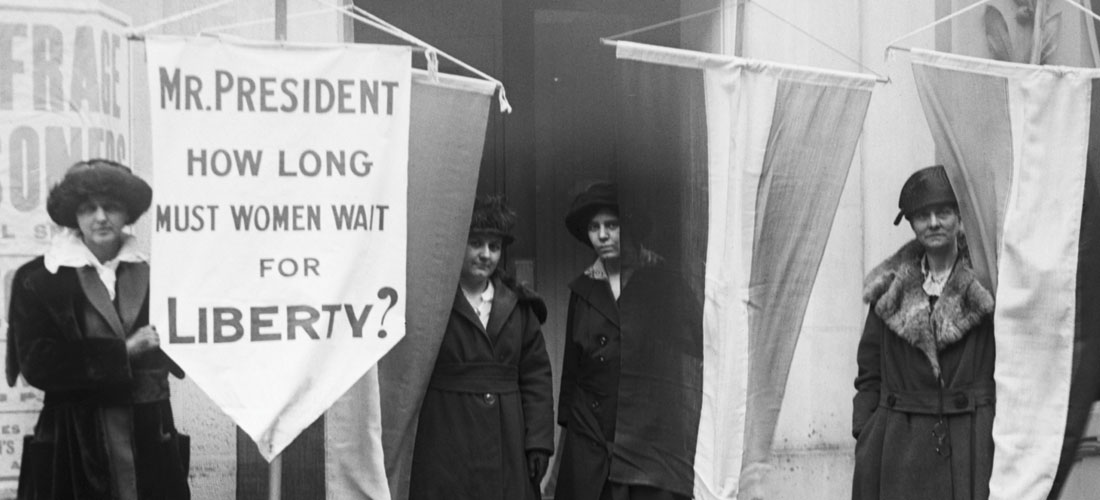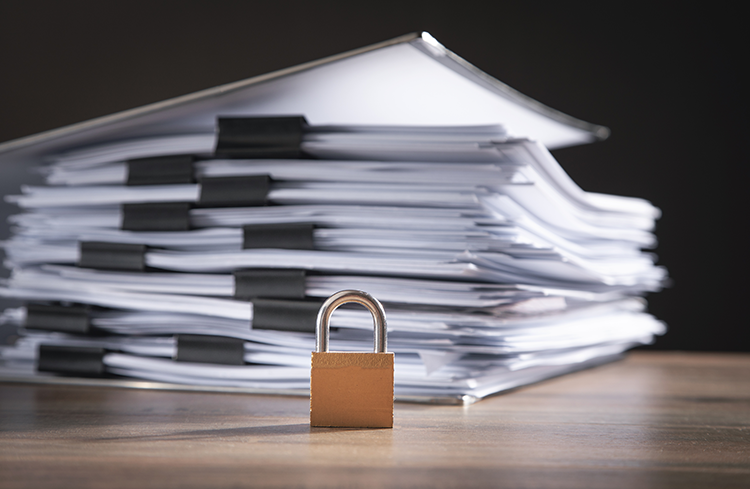Is the right to assemble and demonstrate under threat?

Suffragists (pictured here in New York City) in 1917 became the first group to protest at the White House. (Photo by Bettmann/Contributor via Getty Images)
Nearly 60 years after the U.S. Supreme Court established a key First Amendment precedent protecting protesters’ rights, the freedom to assemble and the right to protest have once again been called into question.
On March 2, 1961, a young James Clyburn and nearly 200 other young African Americans marched from Zion Baptist Church in Columbia, South Carolina, to the statehouse grounds, protesting segregation.
Their own peaceful protests led to arrests for breach of the peace. Ultimately, the U.S. Supreme Court vindicated Clyburn, who is now the U.S. House majority whip, and other activists in Edwards v. South Carolina (1963), ruling the First Amendment protected the right to peaceful protests.
“I wore that arrest like a badge of honor,” Clyburn says. “But I see many similarities between the protests in the ’60s and the social justice protests of today.
“Now, there are attempts to silence protesters again,” Clyburn adds, referring to an array of new measures that ostensibly seek to mute the voices of protesters or at least reduce their impact.
Social activism has escalated in recent years with the growth of women’s marches after the election of President Donald Trump, the Black Lives Matter movement, and in reaction to mass shootings and the deaths of African Americans at the hands of law enforcement officials.
Legislators who are now seeking to restrict protesters say the measures are necessary to establish law and order; provide security; protect businesses; ensure the free flow of highways; and distinguish between peaceful protesters and rioters. But free speech experts warn that the legislative trend against protesting is harmful to fundamental First Amendment freedoms.
“Nonviolent protests have been central to social change in the United States, from suffrage to the civil rights movement,” says Nick Robinson, senior legal adviser for the International Center for Not-for-Profit Law’s U.S. Program. “Anti-protest bills … undermine the ability of Americans to exercise their constitutional right to be heard and stifle this historical source of positive reform.”
Wave of protest legislation
The level of anti-protest legislation has spiked significantly since 2017. According to the ICNL’s U.S. Protest Law Tracker, there have been 230 anti-protest bills introduced in states since January 2017, with the legislative response escalating significantly in 2021.
“This was an unprecedented year,” Robinson says. In 2021, there have been “more bills introduced, and a broader range of tactics used to undermine the right to peaceful assembly.”
The tracker reveals 89 state and federal measures had been introduced so far in 2021 by press time. The measures fall into several categories, including:
• Charging fees for a permit to hold a public protest.
• Limiting where protests can take place or even eliminating protests in certain locations.
• Enhancing penalties for protesting near critical infrastructure areas, such as pipelines.
• Creating new crimes and/or enhancing existing definitions of crimes of disorderly conduct or rioting.
• Criminalizing the taunting of police officers.
• Granting immunity for drivers who injure protesters.
A handful of bills have passed, including a Florida measure passed in April 2021 called the Combating Public Disorder Act, which expands the definition of rioting and allows property owners to sue cities that fail to provide protection to property and businesses.
“This bill protects law enforcement and our residents by making it more difficult for local municipalities to defund their police and obligates municipalities to provide sufficient law enforcement to protect their residents in case of civil unrest,” says Florida Republican Rep. Juan Fernandez-Barquin, the bill’s chief sponsor. “This legislation narrowly tailors the definition of ‘riot’ to apply specifically to violent participants and enhances criminal penalties for rioters, while at the same time protecting peaceful protesters.”
Activist groups such as the Dream Defenders, Black Lives Matter Alliance Broward and others have challenged the law in federal court. “On its face, the act is both overbroad and vague,” the complaint in Dream Defenders v. DeSantis reads. “It subjects nonviolent protesters to criminal liability for exercising protected rights to speech and assembly.”
Chief Judge Mark E. Walker of the U.S. District Court for the Northern District of Florida rejected the government’s motion to dismiss on Aug. 9, and then granted a preliminary injunction in a Sept. 9 order. The judge compared the current law to Florida’s anti-riot laws that were used to arrest protesters opposing Jim Crow in 1956 and 1961. Walker found the law’s new definition of “riot” to be both too vague and too broad. “Though what’s past is prologue, this court need not give it any power beyond providing context for the case now before it,” he concluded.
Arkansas passed a measure that expands the definition of rioting. “The riot bill that I sponsored provided clarification to existing statutes,” says state Republican Rep. Karilyn Brown. “It only addresses riots, not peaceful demonstrations and was written to provide protections for all first responders.”
Also in 2021, Alabama passed a law that allows government officials to charge fees to protest organizers; Arkansas passed a law in April that increases the penalties for obstructing a “public passage” and expands the definition of rioting; Arkansas and Montana also passed laws increasing penalties for protesting near gas and oil pipelines; Oklahoma passed a law that creates new penalties for protesters who obstruct traffic and protects drivers who unintentionally injure or kill protesters acting out of a reasonable belief that they need to flee for their safety; and Tennessee passed a law that expanded the definition of an aggravated riot.
Free speech experts recoil at some of these legislative measures. Any legislation that creates “immunity from criminal liability for drivers who are supposedly fleeing protesters is ripe for abuse and misuse,” says Clay Calvert, director of the Marion B. Brechner First Amendment Project at the University of Florida College of Journalism and Communications.
Free-speech expert Kevin F. O’Neill of Cleveland-Marshall College of Law expresses concern over a Tennessee law passed in August 2020 that limits protests near the state capitol in Nashville.
“Protests should be permitted near the seats of government because the protesters’ message is so often directed at government,” O’Neill says.
“The first protest in front of the White House was staged in 1917 by suffragist leader Alice Paul, who sought to pressure President Woodrow Wilson to support equal voting rights for women,” O’Neill adds. “So there is a long tradition of protesting outside the seats of government in this country, and that tradition should be preserved.”
Suzanne Nossel, CEO of PEN America, an association of writers, worries about the impact of limiting or prohibiting protests at places containing critical infrastructure.
Many of the bills, Nossel says, “are modeled after a sample piece of legislation drafted by the American Legislative Exchange Council, which broadly seeks to create penalties for crimes relating to trespassing on ‘critical infrastructure’—a notably malleable term.”
Protests’ history and future
Throughout American history, vigorous protest and political dissent have been met with significant governmental opposition.
Only seven years after the ratification of the Bill of Rights, Congress passed the Sedition Act of 1798, which essentially made it a crime to criticize Federalist government officials, including President John Adams.
“American history is replete with legislative action calculated to chill protest,” says free speech expert Rodney A. Smolla, dean of the Widener University Delaware Law School. “This dark impulse to censor was manifest in the Alien and Sedition Acts, the espionage laws passed during World War I, McCarthyism and communist witch hunting, and the suppression of the civil rights movement and anti-Vietnam protests.”
“History has rightly judged all of these episodes in censorship and repression harshly as exemplars of all that is not consistent with our national commitment to freedom of speech,” Smolla says. He predicts recent efforts will be struck down in the state and federal courts.
Free speech experts worry these anti-protest bills will have a chilling effect. Calvert says many of them are “legal warnings that people should closely cabin and confine the exercise of their First Amendment rights of speech and assembly or else risk severe consequences.
“The chilling effect from combining severe penalties with nebulous language can be enormous. It’s a double whammy to the First Amendment,” he adds.
Clyburn, who fought to protect the right to protest, points out the country was founded on that right.
“We must ensure that this fundamental right remains protected,” he says.
This story was originally published in the December 2021/January 2022 issue of the ABA Journal under the headline: “Protest Unrest: Is the right to assemble and demonstrate under threat?”
Write a letter to the editor, share a story tip or update, or report an error.


